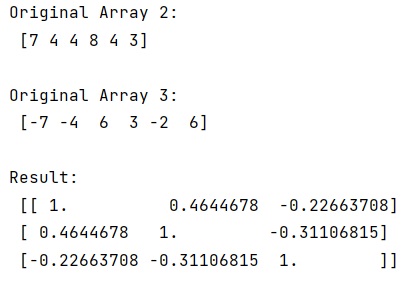Home »
Python »
Python Programs
Why does corrcoef return a matrix?
Learn, why does corrcoef return a matrix in Python?
By Pranit Sharma Last updated : October 09, 2023
NumPy is an abbreviated form of Numerical Python. It is used for different types of scientific operations in python. Numpy is a vast library in python which is used for almost every kind of scientific or mathematical operation. It is itself an array which is a collection of various methods and functions for processing the arrays.
Basically, corrcoef is used to find the correlation coefficients of two given arrays. It returns Pearson product-moment correlation coefficients.
The relationship between the correlation coefficient matrix, R, and the covariance matrix, C, is

The value of R is between -1 and 1, inclusive.
It takes an array as an argument which can be a 1-D or 2-D array containing multiple variables and observations. Each row of the array represents a variable, and each column is a single observation of all those variables.
If we pass 3 different 1-dimensional arrays in this method simultaneously, the two-data-set case becomes a special case of N-data-set class.
Let us understand with the help of an example,
Python program to demonstrate why does corrcoef return a matrix?
# Import numpy
import numpy as np
from numpy import *
# Creating numpy arrays
arr1 = np.array([3,6,3,6,3,2])
arr2 = np.array([7,4,4,8,4,3])
arr3 = np.array([-7,-4,6,3,-2,6])
# Display original arrays
print("Original Array 1:\n",arr1,"\n")
print("Original Array 2:\n",arr2,"\n")
print("Original Array 3:\n",arr3,"\n")
# Using corrcoef method
res = corrcoef([arr1,arr2,arr3])
# Display result
print("Result:\n",res,"\n")
Output
The output of the above program is:

Python NumPy Programs »
Advertisement
Advertisement